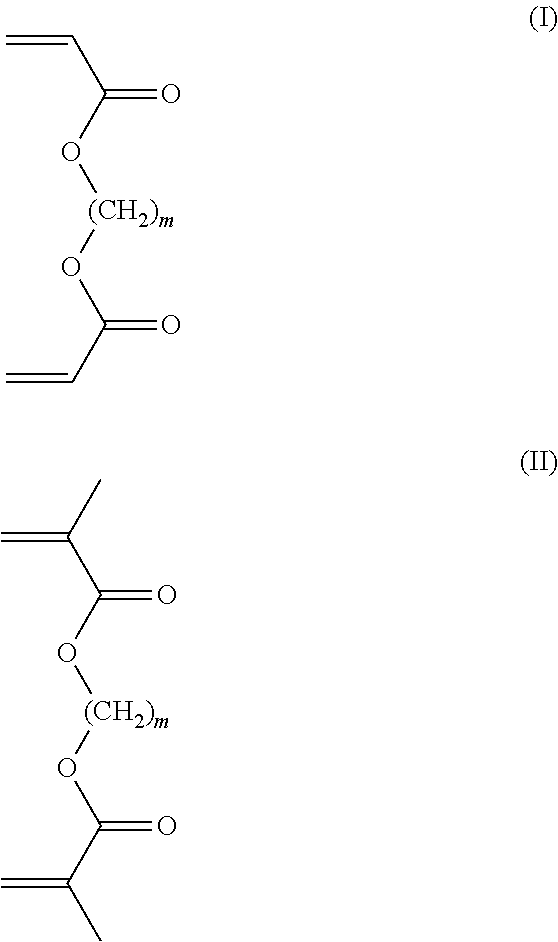Plastic scintillator materials, plastic scintillators comprising such materials and method for distinguishing neutrons from gamma rays using said scintillators
a scintillator and material technology, applied in the direction of radiation intensity measurement, x/gamma/cosmic radiation measurement, instruments, etc., can solve the problems of inability to distinguish neutrons by pulse shape, inability to achieve discrimination, and inability to use, etc., to achieve excellent scintillation properties, excellent discrimination properties, excellent physico-chemical properties
- Summary
- Abstract
- Description
- Claims
- Application Information
AI Technical Summary
Benefits of technology
Problems solved by technology
Method used
Image
Examples
example 1
[0180]In this example, a plastic scintillator according to the invention is prepared.
[0181]Pure styrene (66.62% by mass of the 1,268 g mixture), pure 1,4-butanediyl dimethacrylate (16.65% by mass of the mixture, 317 g), biphenyl (16.65% by mass of the mixture, 317 g) and POPOP (0.08% by mass of the mixture, 1.37 g) are mixed under an inert atmosphere in a dry flask.
[0182]The mixture is rid of any gas by the cold degassing method in vacuo (corresponding to the “freeze-pump-thaw” terminology), and then it is poured with precaution into a glass mould elaborated for giving the final shape of the plastic scintillator to be obtained.
[0183]Typically, the glass mould used within the scope of this example is a cylindrical glass bottle with contents of 2.5 L.
[0184]The mixture placed in the mould is heated to 50° C. for 7 to 14 days.
[0185]The obtained product is then removed from the mould, reworked with the lathe and then polished on one of its two largest sides until a surface condition opti...
example 2
[0197]In this example, a plastic scintillator according to the invention is prepared.
[0198]Pure styrene (66.62% by mass of the mixture, 16.308 g), pure 1,4-butanediyl dimethacrylate (16.65% by mass of the mixture, 4.077 g), biphenyl (16.65% by mass of the mixture, 4.077 g), POPOP (0.08% by mass of the mixture, 20.4 mg) and perylene (0.004% by mass of the mixture, 1.0 mg) are mixed under an inert atmosphere in a dry flask.
[0199]The mixture is rid of any gas by the cold degassing method in vacuo (corresponds to the “freeze-pump-thaw” terminology), and then is poured with precaution into a glass mould elaborated for giving the final shape of the plastic scintillator to be obtained.
[0200]Typically, the glass mould used within the scope of this example is a cylindrical glass bottle with a capacity of 50 mL.
[0201]The mixture placed in the mould is heated to 60° C. for 7 to 14 days.
[0202]The obtained product is then removed from the mould, reworked with the lathe and then polished on one o...
example 3
[0206]In this example, a plastic scintillator according to the invention is prepared.
[0207]Pure styrene (62.07% by mass of the mixture 7.248 g), pure 1,4-butanediyl dimethacrylate (15.60% by mass of the mixture, 1.822 g), biphenyl (15.60% by mass of the mixture, 1.822 g), p-terphenyl (3.00% by mass of the mixture, 350 mg), POPOP (0.04% by mass of the mixture, 5 mg) and o-carborane (3.68% by mass of the mixture, 430 mg) are mixed under an inert atmosphere in a dry flask.
[0208]The mixture is rid of any gas by the cold degassing method in vacuo (corresponding to the “freeze-pump-thaw” terminology), and then it is poured with precaution into a glass mould elaborated for giving the final shape of the plastic scintillator to be obtained.
[0209]Typically, the glass mould used within the scope of this example is a cylindrical glass bottle with a capacity of 50 mL.
[0210]The mixture placed in the mould is heated to 60° C. and 90° C. for 7 to 14 days.
[0211]The obtained product is then removed f...
PUM
| Property | Measurement | Unit |
|---|---|---|
| Fraction | aaaaa | aaaaa |
| Fraction | aaaaa | aaaaa |
| Fraction | aaaaa | aaaaa |
Abstract
Description
Claims
Application Information
 Login to View More
Login to View More - R&D
- Intellectual Property
- Life Sciences
- Materials
- Tech Scout
- Unparalleled Data Quality
- Higher Quality Content
- 60% Fewer Hallucinations
Browse by: Latest US Patents, China's latest patents, Technical Efficacy Thesaurus, Application Domain, Technology Topic, Popular Technical Reports.
© 2025 PatSnap. All rights reserved.Legal|Privacy policy|Modern Slavery Act Transparency Statement|Sitemap|About US| Contact US: help@patsnap.com



